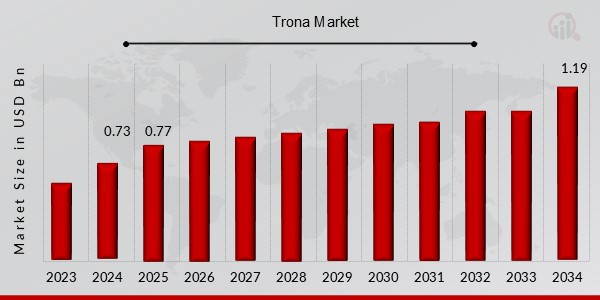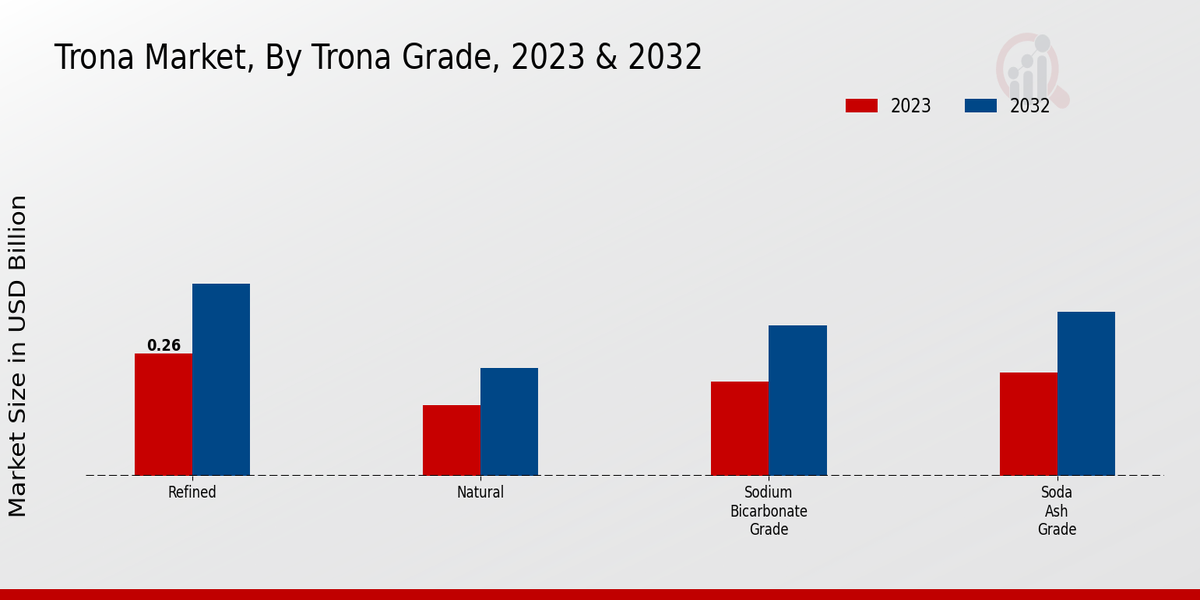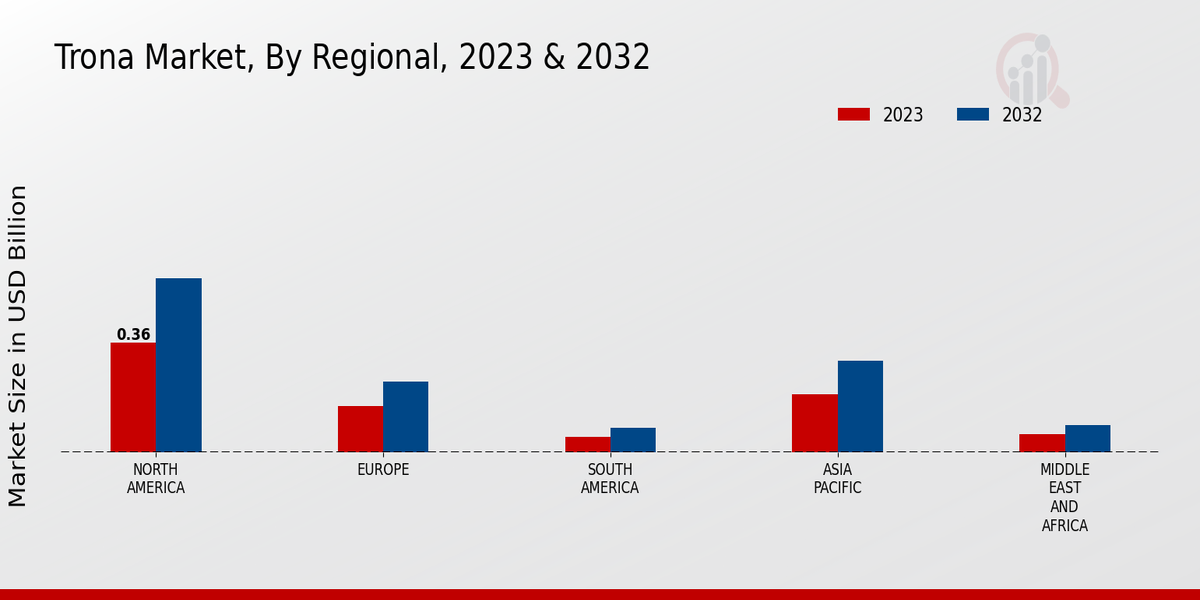Global Trona Market Overview
The Trona Market Size was estimated at 0.73 (USD Billion) in 2024. The Trona Market Industry is expected to grow from 0.77 (USD Billion) in 2025 to 1.19 (USD Billion) by 2034. The Trona Market CAGR (growth rate) is expected to be around 5.01% during the forecast period (2025 - 2034).
Key Trona Market Trends Highlighted
The Trona Market is witnessing significant growth, primarily driven by the increasing demand for soda ash and sodium bicarbonate, which are its primary derivatives. The expansion of the glass, detergent, and paper industries is fueling the surge in soda ash consumption, contributing to the growth of the trona market. The rising demand for sodium bicarbonate in various industries, including food processing, pharmaceuticals, and personal care, is also propelling market expansion. Technological advancements in trona mining and processing techniques are expected to further boost production efficiency and reduce costs, presenting lucrative opportunities for market participants. The increasing adoption of eco-friendly and sustainable mining practices is a notable trend shaping the trona market, as concerns over environmental impact grow. Key players are investing in research and development to enhance trona extraction and processing methods, promoting the industry's long-term growth and profitability.

Source: Primary Research, Secondary Research, MRFR Database and Analyst Review
Trona Market Drivers
Rising Demand for Glass and Glass Products
Trona is a key raw material used in the production of glass, which is widely employed in various industries such as construction, automotive, and consumer goods. The increasing demand for glass and glass products, particularly in emerging economies, is anticipated to drive the growth of the Trona Market. As construction activities accelerate and urbanization expands, the need for glass for buildings, windows, and other applications is expected to rise.Additionally, the growing automotive industry, which utilizes glass for windshields, windows, and other components, is contributing to the demand for trona. The expanding consumer goods sector, which includes products such as tableware, cookware, and decorative items made of glass, is further fueling the market growth.
Expanding Applications in Chemicals and Pharmaceuticals
Beyond its use in glass production, trona finds applications in the chemical and pharmaceutical industries. It is employed in the manufacturing of soda ash, a crucial ingredient in detergents, soaps, and other cleaning products. The rising demand for these products, particularly in developing countries, is expected to stimulate the growth of the Trona Market. Furthermore, trona is utilized in the production of pharmaceuticals, such as antacids and laxatives, contributing to the market's growth in the healthcare sector.
Growing Environmental Regulations and Sustainability Concerns
Stringent environmental regulations and the increasing focus on sustainability are driving the demand for trona as a natural and eco-friendly alternative to other raw materials. Trona's use in glass production reduces emissions and energy consumption compared to traditional methods. Moreover, it is a naturally occurring mineral with a lower environmental impact compared to synthetic chemicals. As governments and consumers become more environmentally conscious, the adoption of trona in various industries is expected to contribute to the growth of the Trona Market.
Trona Market Segment Insights:
Trona Market Trona Grade Insights
The Trona Market is segmented by Trona Grade into Refined, Natural, Sodium Bicarbonate Grade, and Soda Ash Grade. Refined Trona is the most dominant segment and accounts for over 40% of the Trona Market revenue in 2023. It is preferred by various industries, including glass, detergent, and chemicals, due to its high purity and consistent quality. The Natural Trona segment is also witnessing significant growth, primarily driven by the increasing demand from the agriculture sector. Sodium Bicarbonate Grade Trona is gaining traction in the food and beverage industry, while Soda Ash Grade Trona is witnessing increasing adoption in the pulp and paper industry.The Trona Market Segmentation data indicates that the Refined Trona segment is projected to maintain its dominance throughout the forecast period, driven by the expanding glass and detergent industries.

Source: Primary Research, Secondary Research, MRFR Database and Analyst Review
Trona Market End-Use Industry Insights
End-Use Industry The Trona Market is segmented into various end-use industries, including glass glassware, chemicals, pulp paper, mining, detergents soaps, water treatment, and food beverages. Among these, the glass glassware industry holds a prominent share, driven by the increasing demand for trona in the production of flat glass, container glass, and specialty glass. The chemicals industry also represents a significant segment, primarily utilizing trona for the manufacturing of soda ash, a key raw material in the production of glass, detergents, and other chemicals.Pulp paper, mining, detergents soaps, water treatment, and food beverages industries also contribute to the trona market's growth, with trona being used in various applications such as papermaking, water softening, and food preservation. The overall Trona Market revenue is projected to grow significantly in the coming years, fueled by the increasing demand from these end-use industries and the rising global population.
Trona Market Application Insights
The Trona Market has various applications, including container glass, flat glass, TV glass, fine chemicals, pharmaceuticals, sodium carbonate, potassium carbonate, pulp paper products, mining chemicals, batteries, abrasives, and animal feed. Among these, container glass and flat glass are the significant application segments, collectively accounting for over 60% of the Trona Market revenue. The demand for container glass is driven by the growing consumption of beverages and food products, while the increasing construction activities worldwide fuel the demand for flat glass.Moreover, the growing demand for fine chemicals, pharmaceuticals, and other industrial applications is expected to propel the market growth further.
Trona Market Sales Channel Insights
The Trona Market is segmented into various sales channels, including direct sales, distributors, and e-commerce. In 2023, the direct sales channel accounted for the largest share of the market, owing to the strong relationships between manufacturers and customers. Direct sales allow for better control over product quality, pricing, and customer service. Distributors play a crucial role in expanding market reach and providing localized support to customers. E-commerce is gaining traction due to its convenience, wider product selection, and competitive pricing.The growing adoption of e-commerce is expected to drive the growth of the Trona Market in the coming years.
Trona Market Regional Insights
The regional segmentation of the Trona Market offers insights into the market's performance and growth potential across different regions. North America holds a dominant share in the market, driven by the presence of major trona mining and processing facilities in the United States. The region is expected to maintain its leading position in the coming years. Europe is another significant market for trona, with demand from various industries, including glass, detergent, and paper manufacturing. The APAC region is witnessing a steady growth in trona consumption, primarily due to the expanding industrial base in countries like China and India.South America and MEA are relatively smaller markets for trona but are expected to witness moderate growth in the future. The Trona Market revenue in 2023 is estimated to be around 0.66 billion USD, with projections indicating a growth to 1.02 billion USD by 2032, exhibiting a CAGR of 5.01%. This growth is attributed to the increasing demand for trona in various end-use industries and the expansion of the construction sector in emerging economies.

Source: Primary Research, Secondary Research, MRFR Database and Analyst Review
Trona Market Key Players And Competitive Insights:
Major players in the Trona Market industry are constantly striving to gain a competitive edge by investing in research and development, expanding their product portfolios, and forging strategic partnerships. Leading Trona Market players are focusing on developing innovative technologies and solutions to meet the evolving needs of their customers. The competitive landscape of the Trona Market is characterized by a mix of established players and emerging entrants. Key players are adopting various strategies, including mergers and acquisitions, joint ventures, and partnerships, to strengthen their market position. To stay competitive, companies are also investing heavily in marketing and promotional activities to raise brand awareness and generate demand for their products.
The Trona Market is expected to witness increased competition in the coming years, as new entrants seek to capitalize on the growing demand for Trona.FMC Corporation is a leading player in the Trona Market. The company has a strong global presence with operations in over 100 countries. FMC Corporation offers a wide range of Trona products, including soda ash, sodium bicarbonate, and trisodium phosphate. The company's Trona products are used in a variety of applications, including glass manufacturing, food processing, and water treatment. FMC Corporation is committed to providing high-quality Trona products and services to its customers. The company has a team of experienced professionals who are dedicated to meeting the needs of its customers. FMC Corporation is also committed to sustainability and operates its business in a responsible manner.Tata Chemicals is a major competitor in the Trona Market. The company is headquartered in India and has operations in over 40 countries. Tata Chemicals offers a wide range of Trona products, including soda ash, sodium bicarbonate, and sodium sulfate. The company's Trona products are used in a variety of applications, including glass manufacturing, detergents, and papermaking. Tata Chemicals is committed to providing high-quality Trona products and services to its customers. The company has a team of experienced professionals who are dedicated to meeting the needs of its customers. Tata Chemicals is also committed to sustainability and operates its business in a responsible manner.
Key Companies in the Trona Market Include:
- Searles Valley Minerals
- Tata Chemicals
- RIO TINTO
- Tiankai Chemical
- Tronox
- Jiangxi Dingsheng Chemical
- Anzhong Group
- Sichuan Tianyuan Chemical
- Chengxing Investment
- Meibao Group
- Qinghai Yihua
- Sichuan Grand SciTech
- Xinxiang Southeast Zhe Cheng
- Shanxi Dadi Group
Trona Market Industry Developments
Rising demand for soda, are in glass, detergent, and chemical manufacturing industries is driving market growth. Trona is a naturally occurring mineral composed of sodium carbonate, sodium bicarbonate, and water. It is primarily used to produce soda ash, a key ingredient in glass manufacturing. The growing construction sector in developing countries is fueling demand for soda ash, thus indirectly driving the trona market. Key market players are focusing on expanding their production capacities and exploring new markets to meet the increasing demand. Strategic collaborations and partnerships are also being formed to enhance market presence and gain a competitive edge.
Trona Market Segmentation Insights
- Trona Market Trona Grade Outlook
- Refined
- Natural
- Sodium Bicarbonate Grade
- Soda Ash Grade
- Trona Market End-Use Industry Outlook
- Glass Glassware
- Chemicals
- Pulp Paper
- Mining
- Detergents Soaps
- Water Treatment
- Food Beverages
- Trona Market Application Outlook
- Container Glass
- Flat Glass
- TV Glass
- Fine Chemicals
- Pharmaceuticals
- Sodium Carbonate
- Potassium Carbonate
- Pulp Paper Products
- Mining Chemicals
- Batteries
- Abrasives
- Animal Feed
- Trona Market Sales Channel Outlook
- Direct Sales
- Distributors
- E-commerce
- Trona Market Regional Outlook
- North America
- Europe
- South America
- Asia Pacific
- Middle East and Africa
| Report Attribute/Metric |
Details |
| Market Size 2024 |
0.73 (USD Billion) |
| Market Size 2025 |
0.77 (USD Billion) |
| Market Size 2034 |
1.19 (USD Billion) |
| Compound Annual Growth Rate (CAGR) |
5.01% (2024 - 2032) |
| Report Coverage |
Revenue Forecast, Competitive Landscape, Growth Factors, and Trends |
| Base Year |
2024 |
| Market Forecast Period |
2025 - 2034 |
| Historical Data |
2020 - 2024 |
| Market Forecast Units |
USD Billion |
| Key Companies Profiled |
Searles Valley Minerals, Tata Chemicals, RIO TINTO, Tiankai Chemical, Tronox, Jiangxi Dingsheng Chemical, Anzhong Group, Sichuan Tianyuan Chemical, Chengxing Investment, Meibao Group, Qinghai Yihua, Sichuan Grand SciTech, Xinxiang Southeast Zhe Cheng, Shanxi Dadi Group |
| Segments Covered |
Trona Grade, End-Use Industry, Application, Sales Channel, Regional |
| Key Market Opportunities |
· Glass production expansion · Growing demand for glass containers · Detergent industry growth · Flue gas desulfurization · Soda ash production increase |
| Key Market Dynamics |
Increased glass and detergent demand, Rising urbanization in emerging economies, Government regulations on soda ash production, Technological advancements in trona mining, Expansion of chemical industry |
| Countries Covered |
North America, Europe, APAC, South America, MEA |
Frequently Asked Questions (FAQ) :
The Trona market is expected to reach a valuation of approximately 0.73 USD Billion in 2024.
By 2034, the Trona market is projected to reach a valuation of 1.19 USD Billion, exhibiting a CAGR of 5.01% over the 2025 - 2034 period.
Key regions driving the Trona market's growth include North America, Asia Pacific, Europe, and the Middle East Africa.
Trona finds applications in various industries, including glass manufacturing, detergent production, and water treatment.
Major players in the Trona market include Solvay, Tata Chemicals, and Searles Valley Minerals.
Factors driving the growth of the Trona market include rising demand for glass and detergents, increasing urbanization, and growing environmental concerns.
Challenges faced by the Trona industry include fluctuating raw material prices, stringent environmental regulations, and intense competition.
Technological advancements, such as improved mining techniques and energy-efficient processes, are optimizing production and reducing costs in the Trona market.
Emerging trends in the Trona market include the adoption of sustainable practices, increased focus on product quality, and the development of innovative applications.
The Trona Market is expected to witness steady growth over the next decade, driven by increasing demand from end-use industries and ongoing technological advancements.
















